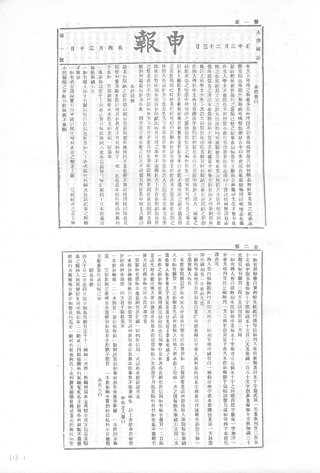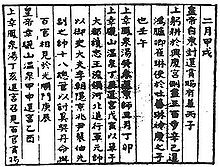The Hong Kong Commercial Daily (HKCD) is a Chinese state-owned newspaper, published in broadsheet format in Hong Kong and dubbed “China’s international media window” by the central government. Established in 1952, it was the first financial newspaper in the Chinese language. It is one of the few newspapers authorized by the Hong Kong SAR government to publicize legal announcements, and also the only Hong Kong newspaper allowed to be circulated freely in mainland China. It is controlled by the Hong Kong Liaison Office and has a branch office in Shenzhen.

Zheng Zhenduo, courtesy name Xidi, was a Chinese journalist, writer, archaeologist and scholar. His pen names were Baofen (寶芬), Guo Yuanxin (郭源新) and CT.

Shao Piaoping was a journalist, author, and political activist in China during the early 20th century. He was originally named Jingqing (鏡清), and later renamed himself Zhenqing (振青).

Huang Yuanyong (黃遠庸), was a renowned Chinese author and journalist during the late Qing dynasty (清朝) and early Republic of China (民國初年). Huang made significant contributions to journalism and literacy in China, particularly as an innovator in both journalistic methodology and writing style. His unsolved assassination while visiting San Francisco, California, United States, was suspected of having been a KMT operation.

The Quebec Chronicle-Telegraph, founded by William Brown as the Quebec Gazette on 21 June 1764, is the oldest running newspaper in North America. It is currently published as an English language weekly from its offices in Quebec City, Quebec, Canada.

The modern newspaper is a European invention. The oldest direct handwritten news sheets circulated widely in Venice as early as 1566. These weekly news sheets were full of information on wars and politics in Italy and Europe. The first printed newspapers were published weekly in Germany from 1605. Typically, they were censored by the government, especially in France, and reported mostly foreign news and current prices. After the English government relaxed censorship in 1695, newspapers flourished in London and a few other cities including Boston and Philadelphia. By the 1830s, high-speed presses could print thousands of papers cheaply, allowing low daily costs.
Dibao, literally "reports from the [official] residences", were a type of publications issued by central and local governments in imperial China, which was the only official government newspaper published by the ancient Chinese central government in different dynasties. 'Dibao' is a general term to describe the ancient Chinese gazette. Historically, there were different types of names used to describe Dibao in different dynasties among the imperial Chinese history. While closest in form and function to gazettes in the Western world, they have also been called "palace reports" or "imperial bulletins". Different sources place Dibao's first publication as early as the Han dynasty, which would make Dibao amongst the earliest newspapers in the world, or as late as the Tang dynasty according to the earliest verified and proved Dibao with historical relics. Dibao was continuously published among different imperial dynasties until the last imperial emperor in the Qing dynasty, Puyi, abdicated in 1912.
The Peking Gazette was an official bulletin published with changing frequency in Beijing until 1912, when the Qing dynasty fell and Republican China was born. The translated name, as it is known to Western sources, comes from Ming dynasty-era Jesuits, who followed the bulletin for its political contents. The Peking Gazette became a venue for political grievances and infighting during the reign of the Wanli Emperor in the late Ming dynasty, when literati factions would submit politicized memorials that the Emperor often abstained from reviewing. From around 1730, the publication was in Chinese called Jing Bao, literally "the Capital Report". It contained information on court appointments, edicts, and the official memorials submitted to the emperor, and the decisions made or deferred.
The forerunners of newspapers in China took the form of government bulletins such as the Peking Gazette. Newspapers as known in the West were first published in China in the early 19th century. Some were in the English language rather than Chinese, and many were allied with Christian missionary endeavours.

A newspaper is a periodical publication containing written information about current events and is often typed in black ink with a white or gray background. Newspapers can cover a wide variety of fields such as politics, business, sports, art, and science. They often include materials such as opinion columns, weather forecasts, reviews of local services, obituaries, birth notices, crosswords, editorial cartoons, comic strips, and advice columns.

The Qapqal News is the world's only newspaper in the Xibe language, a Tungusic language spoken in Northwest China. It is one of roughly fifty minority-language newspapers in the Xinjiang autonomous region of China.

Shen Bao, formerly transliterated as Shun Pao or Shen-pao, known in English as Shanghai News, was a newspaper published from 30 April 1872 to 27 May 1949 in Shanghai, China. The name is short for Shenjiang Xinbao, Shenjiang being a short form of Chunshen Jiang, the old name for the Huangpu River.
The Shanghai Jewish Chronicle was a Jewish newspaper operating in Shanghai, China. It was a German language newspaper that was originally published daily and later published weekly.
China Writers Association or Chinese Writers Association is a subordinate people's organization of the China Federation of Literary and Art Circles (CFLAC). Founded in July 1949, the organization was initially named the China National Literature Workers Association. In September 1953, it was renamed the China Writers Association. The association's leadership was purged shortly after the 1989 Tiananmen Square protests and massacre. In April 2012, the organization changed its translated name to China Writers Association.
Wenyi Bao 文艺报 is a Chinese-language newspaper about Chinese literature and art, that is published three times a week. It is issued by the China Writers Association and is published by the Xinhua Bookstore in Beijing. The name of the paper is sometimes written as Wenyi bao or Wenyibao.

The Kaiyuan Tongbao, sometimes romanised as Kai Yuan Tong Bao or using the archaic Wade-Giles spelling K'ai Yuan T'ung Pao, was a Tang dynasty cash coin that was produced from 621 under the reign of Emperor Gaozu and remained in production for most of the Tang dynasty until 907. The Kaiyuan Tongbao was notably the first cash coin to use the inscription tōng bǎo (通寶) and an era title as opposed to have an inscription based on the weight of the coin as was the case with Ban Liang, Wu Zhu and many other earlier types of Chinese cash coins. The Kaiyuan Tongbao's calligraphy and inscription inspired subsequent Central Asian, Japanese, Korean, Ryūkyūan, and Vietnamese cash coins and became the standard until the last cash coin to use the inscription "通寶" was cast until the early 1940s in French Indochina.

The coinage of the Southern Tang dynasty consisted mostly of bronze cash coins while the coinages of previous dynasties still circulated in the Southern Tang most of the cash coins issued during this period were cast in relation to these being valued as a multiple of them.

Ma Hsin-yeh was born in Pingyang County, Zhejiang Province, and enjoyed a notable career as a pioneering Chinese journalist, educator, publisher, government executive and diplomat. Ma was known as the "King of Journalism" (新聞王), and collectively with his native place compatriots Xie Xia-xun the "Chess King" and Su Bu-qing the "Math King", were known as the "Three Kings of Pingyang" (平陽三王). The Pingyang County Government has also officially named Ma as one of the top-ten most significant cultural-historical figures of the county. Ma adopted his penname Hsin-yeh as his personal name some time following his study abroad at the University of Missouri School of Journalism. The name incorporates the two characters for "stars" and "plain" from a line in the Tang dynasty poet Du Fu's poem Thoughts When Traveling at Night: "Stars hang low above the wide, flat plain, And up rides the moon as the mighty river flows on". Years later in 1984 when Ma was head of the Central News Agency, the School awarded him its highest honor, the Missouri Honor Medal for Distinguished Service in Journalism.











